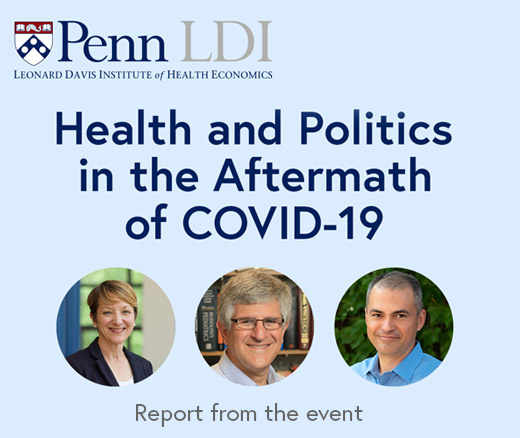
Contradictions That Confuse Federal Food Policies
Announcing Bold New Goals While Crippling the Infrastructure Needed to Achieve Them
Population Health
Blog Post

For decades, research on U.S. mortality trends has focused on the struggles of white Americans and the “deaths of despair.” Less known are the fates of Black Americans whose life expectancy varies dramatically across the American landscape. Blacks live longest in large metropolitan areas and in regions like the Northeast and South Atlantic while those in smaller cities, rural areas, and much of the deep South and Midwest saw far smaller gains—or even reversals after 2010.
Especially troubling are the rising death rates among young Black adults aged 25 to 44, a trend that underscores how geography can affect survival.
In a new study, LDI Senior Fellow Irma Elo with Anneliese Luck, a former graduate student and LDI Associate Fellow, homed in on non-Hispanic Black mortality and its growing geographic divergence from 1990 to 2019 in part because it has gotten less attention.
Her team’s findings – discussed below — matter now more than ever. Cuts to Medicaid and the Affordable Care Act threaten to deepen long-standing disparities that were worsened by the COVID-19 pandemic. By highlighting these patterns, this research calls for policymakers to improve neighborhoods, and create employment, educational and training opportunities to support longer, healthier lives for Black Americans across the country.
Elo: We document considerable geographic divergence in Black male and female life expectancies since 1990 with the largest improvements in large central and large fringe metropolitan areas and smallest improvements in small/medium metros and nonmetropolitan areas. We also document sizable differences across regions, with the largest gains in the Northeast and the South Atlantic region and the smallest gains in other parts of the South and the Midwest. Most gains were achieved by 2010 with stagnating or declining life expectancies thereafter. We find particularly adverse trends in the Midwest after 2010 where Black life expectancies declined in all metro categories. The increase in mortality was particularly notable among young adults at ages 25-44. Our study is the first to document this geographic divergence in Black mortality since 1990 at this level of detail.
Elo: We and others have documented a disproportionate impact of the pandemic on Black American mortality with large reductions in life expectancy particularly in 2020 and 2021. We have published several papers that examine the impact of the COVID-19 pandemic on the mortality of Black, White and Hispanic Americans.
Elo: Although we provide some discussion of the potential explanatory factors, we do not empirically test causal explanations for theses trends. However, we provide a comprehensive review of the potential roles that geographic divergence in educational expansion, increase in the foreign-born Black population and suburbanization might have had in shaping the mortality trends we document. We also highlight potential explanations underlying cause-specific findings, including the introduction of HIV/AIDs treatment, the onset of the drug epidemic, as well as trends in key health behaviors, such as obesity, smoking, and gun violence. But clearly much more research is needed to unpack the factors responsible for the extensive geographic divergence that we describe. We hope that we have succeeded in calling for greater attention to the study of non-Hispanic Black mortality.
Elo: One of the most disturbing recent mortality trends we document is the increase in Black male and female mortality in young adulthood, at ages 25-44. These trends were most adverse in the Midwest but also present elsewhere. We also document adverse trends at older working ages, 45-64, especially in smaller metropolitan areas and nonmetropolitan areas since 2010. There is an urgent need to improve the lived circumstances of working-age Black men and women through investing in neighborhoods, expanding access to quality employment, and improving educational and training opportunities across the life course.
Elo: We are continuing to investigate geographic and state-level trends and differences in mortality, shifting our attention now to differences among US-born and foreign-born residents. In particular, we are interested in examining the contribution of the foreign-born population to trends in state-level and geographic differences in mortality by region and metropolitan-nonmetropolitan continuum.
The study, “Pre-COVID-19 Geographic Inequalities in Non-Hispanic Black U.S. Life Expectancy, 1990–2019,” was published on July 31, 2025 in Population and Development Review. Authors include Irma Elo, Anneliese Luck, and Sylvie Tuder.


Announcing Bold New Goals While Crippling the Infrastructure Needed to Achieve Them

Promising New Evidence and What’s Next

A Penn LDI Seminar Focuses on Why They’re Important for the Future

Former Philadelphia Health Commissioner Warns That Gutting the CDC, Undermining Vaccines, and Politicizing Science Will Leave the U.S. Dangerously Unprepared for the Next Pandemic

Rural Parents Had More Emergency Visits and Insurance Loss Than Urban Peers, an LDI Study Shows. Integrated Baby Visits Could Help All Parents Be Healthier

From Anxiety and Loneliness to Obesity and Gun Deaths, a Sweeping New Study Uncovers a Devastating Decline in the Health and Well-Being of U.S. Children